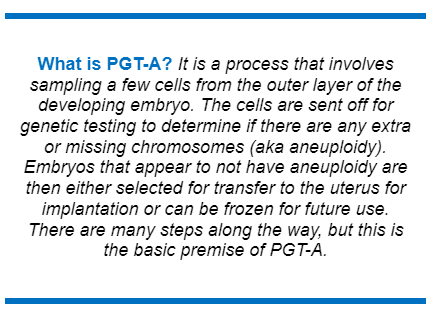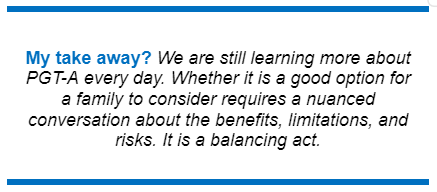By Jenny Rietzler, MS, CGC
In my first year as a reproductive genetic counselor, I had a case that I still reflect on to this day. Without sharing too many specifics, my patient had gone through IVF and she and her partner had decided to have pre-implantation genetic testing for aneuploidy (PGT-A) on their embryos.

Through shared decision-making with her IVF providers, the patient (we will refer to as Holly) decided to transfer an embryo that still had PGT-A results pending. She was at a time in her cycle where she had a high chance of success to become pregnant and she did not want to wait any longer.
A couple weeks later, Holly and her partner finally saw the plus sign they yearned for: a positive pregnancy test.
As they moved further into the pregnancy, PGT-A results returned for the embryo Holly was now carrying. The results suggested that the embryo had multiple extra and missing chromosomes and the findings were mosaic. With lots of uncertainty, Holly and her partner were referred to talk with me about their prenatal genetic testing options. I knew that PGT-A results were not 100% perfect. But what was the chance that their pregnancy truly did have a chromosomal concern? And through further testing, could we ever tell them with certainty that their baby would not have a chromosomal difference?
In preparing for her case I came across a paper by Vera-Rodriguez and Rubio published in 2017 (PMID: 28433370). It was eye opening for me as a new genetic counselor, especially seeing Figure 1. So eye opening that during my time teaching a reproductive genetics class years later, I made sure my students could see the figure, too. The data from this paper suggested that ~60% of embryos diagnosed as mosaic for aneuploidy by PGT-A would be truly mosaic. In most cases, an embryo with aneuploidy would either not implant or would result in an early pregnancy loss depending on the chromosomes involved. For those embryos that did implant, roughly 25-30% would result in a baby with the typical number of chromosomes expected. I remember reviewing this data with the couple, who were surprised by the numbers. They shared they were counseled by their IVF providers that there was a 100% chance to have an abnormal outcome with their PGT-A results. With some hope still left, they decided to move forward with both a CVS and an amniocentesis in their pregnancy. Chromosomal testing from their procedures came back showing the pregnancy had the typical 46 chromosomes and there was no evidence of mosaicism. Ultrasounds in the pregnancy were normal. They now have a healthy son. I now have a letter that sits at my desk: “We can say without hesitation that you were a vital part of our new family even existing. We can’t possibly express how grateful we are. We will just say, from the bottom of our hearts, thank you so much.”

Though it may seem like prenatal testing by CVS and amniocentesis in this setting can give a family full reassurance about a pregnancy outcome, there still ends up being uncertainty about the actual chromosome complement of the baby. Hours were spent counseling Holly and her partner on the ins and outs of the tests, the benefits, the limitations, the risks. We are only sampling certain cell lines of the pregnancy and fetus through CVS and amniocentesis, and residual odds for a chromosomal condition in a child will remain. This happens to be true for any pregnancy. The couple felt informed and were comfortable with their residual odds.
A recent study published online this August came across my LinkedIn by Druckenmiller Cascante et al. (PMID: 37574001). It brought me back to Holly’s case and the data reinforces the fact that results of PGT-A are not straightforward. Briefly, different testing methodologies for PGT-A were used on donated embryos created by IVF to see if PGT-A results remained concordant when embryos were re-biopsied. It was a blinded study and the results from re-biopsies were not always the same.
My take away? We are still learning more about PGT-A every day. Whether it is a good option for a family to consider requires a nuanced conversation about the benefits, limitations, and risks. It is a balancing act. These sensitive discussions are ones we are happy to work through with families at Genetic Support Foundation.

